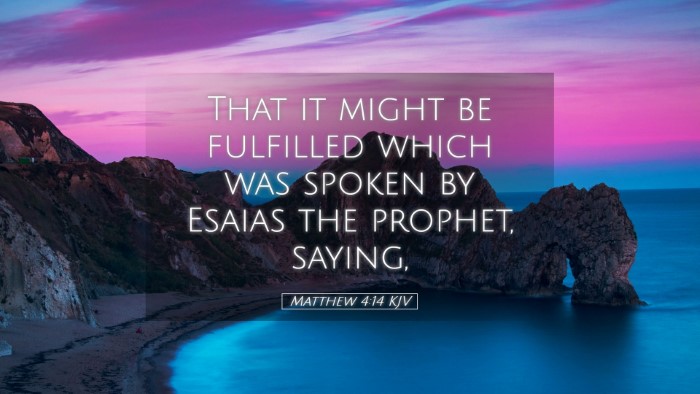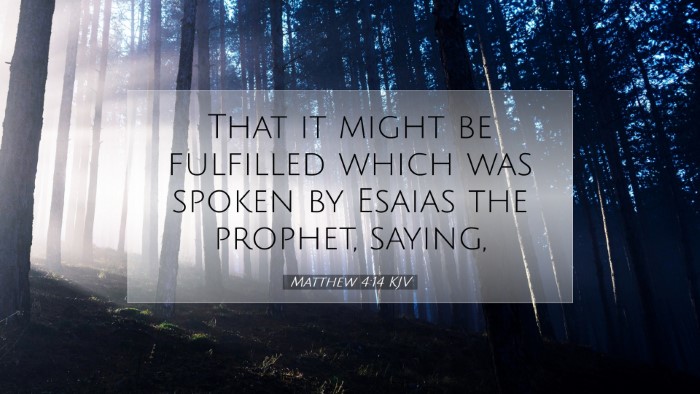Commentary on Matthew 4:14
Matthew 4:14 states: "That it might be fulfilled which was spoken by Esaias the prophet." This verse plays a significant role in illustrating the fulfillment of Old Testament prophecies through the ministry of Jesus Christ. The theological implications and historical contexts surrounding this verse offer rich insights for further exploration.
Contextual Analysis
This passage is nestled within the account of Jesus' early ministry, as He begins to proclaim the Kingdom of God. Following His baptism and temptation in the wilderness, Jesus relocates to Capernaum, a strategic move that aligns with prophetic expectation. The location holds significant importance as it symbolizes the dawning of a new era, bridging the gap between the Jewish prophetic tradition and the arrival of the Messiah.
The Prophetic Fulfillment
Matthew's reference to Isaiah in this passage signals a profound connection between the Old and New Testaments. Specifically, this verse alludes to Isaiah 9:1-2, which speaks about a light arising in darkness. The mission of Jesus, thus, is framed as the embodiment of God’s promise to deliver and illuminate the spiritual landscape of Israel and beyond.
-
Matthew Henry emphasizes that Jesus’ move to Capernaum was not merely geographical; it was doctrinally significant. His commentary underscores the importance of fulfilling prophecy as a means of affirming Jesus’ identity as the Messiah.
-
Albert Barnes elaborates on the symbolism of light. He states, "The coming of Christ is likened to the dawning of a new day, enlightening the hearts of the people, dispelling the shadows of sin and despair." This metaphor serves to illustrate the transformative power of Christ’s ministry.
-
According to Adam Clarke, the specific mention of "Zebulun and Naphtali" is crucial in understanding Christ’s early life and surroundings, illustrating God's unfolding plan amid Israel's history and geography.
Theological Reflections
The hermeneutical implications of Matthew 4:14 extend to your understanding of Christ's mission. Jesus is portrayed not only as a teacher but also as the divine light that commits to dispelling the darkness of ignorance, sin, and alienation from God.
-
The text encourages reflection on the nature of divine fulfillment in history. As pastors and theologians, it invites contemplation on how divine plans can appear obscured in the present yet emerge clearly through the lens of Scripture.
-
For students, this passage can foster an appreciation for the interconnectedness of biblical texts. It serves as a reminder that the Old Testament is not merely a historical document but the foundation on which the New Testament rests.
-
The mention of prophecy calls for a deeper exploration of how fulfillment occurs. Consider the implications of prophetic expectation that culminates in Christ—Challenging believers to engage actively with Scripture, anticipating God’s continuing revelation.
Practical Applications
Understanding Matthew 4:14 offers several practical insights for ministry and teaching.
-
Emphasizing Prophetic Truth: In sermons, highlight the significance of prophecy's fulfillment to bolster faith among congregants, showcasing God's steadfastness and reliability.
-
Preaching and Teaching: Foster discussions on the importance of light versus darkness, framing spiritual growth as a journey toward enlightenment through Christ.
-
Community Engagement: Encourage community outreach that embodies the light of Christ, engaging in acts of service that reflect Christ's transformative message.
Conclusion
Matthew 4:14 encapsulates a moment of divine fulfillment that resonates with the overarching narrative of Scripture. By weaving together the prophetic traditions and the manifestation of Christ’s purpose, this verse invites believers to engage intellectually and spiritually with the life-changing truth of the Gospel. Scholars, pastors, and students alike will find in this passage not only a historical marker but also a call to live in the light of Christ, continuing the mission He commenced.


